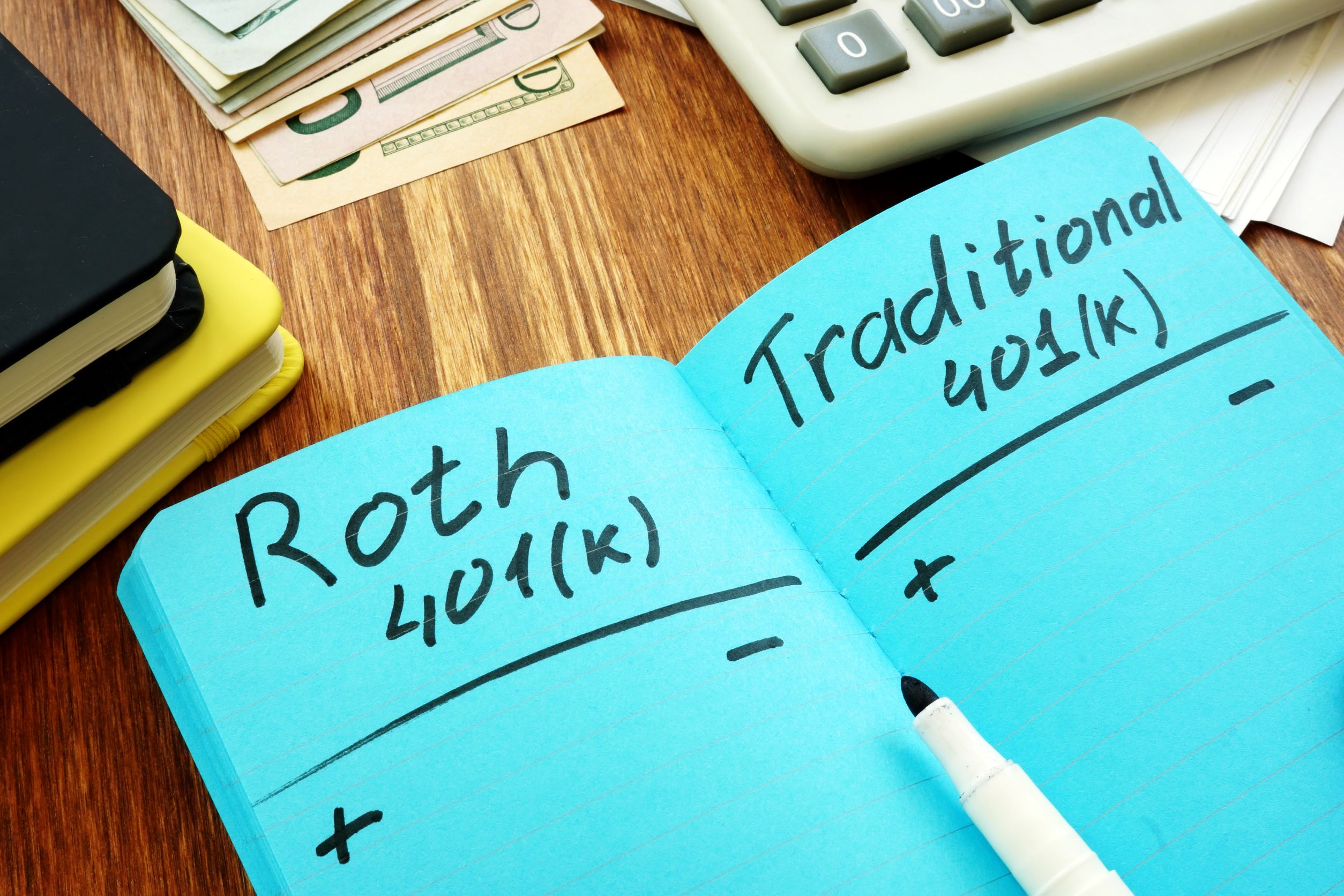Most companies offer their employees the ability to save for retirement. In addition to the traditional 401(k) plan, where contributions made by an employee are tax-deductible from current income, many employers also offer a Roth 401(k) account.
Simply put, a 401(k) plan is a company-sponsored retirement account that allows employees to save for retirement tax-efficiently. The account’s value grows by contributions made by the employee and (sometimes) the employer, coupled with investment performance.
Let’s explore which type of retirement plan─a traditional 401(k) or a Roth 401(k)─is right for you.
Traditional 401(k) Plan vs. Roth 401(k) Plan Comparison
A traditional 401(k) plan is a tax-deferred retirement plan built with pre-tax contributions. For example, if your monthly gross paycheck is $2,000 and you contribute $400 to a 401(k) that month, your monthly taxable income is $1,600. If we assume a 20% tax rate, your tax is $320, and you are left with $1,280 after tax. The $400 you contributed to your IRA grows without being subject to tax until you withdraw the money from the plan in retirement.
The Roth 401(K) plan is a tax-free retirement plan built with after-tax contributions. Using the same example above, if your monthly gross paycheck is $2,000 and you contribute $400 to your Roth 401(k) account instead of your Traditional 401(k) account, your tax will be $400 (20% of $2,000). After your $400 contribution to the Roth 401(k) and the tax, you are left with $1,200. The benefit of the Roth 401(k) is that no income taxes will be due when you begin taking distributions. This applies to the contributions and any earnings the account has.
Which Retirement Savings Plan is Better?
The answer to this question is, “It depends on your future income and taxes.” Do you anticipate being in a higher tax bracket at retirement? If so, a Roth 401(k) plan may make sense now because you are foregoing a current tax deduction at lower tax rates than you would pay in the future when you begin taking distributions. Conversely, if you expect your future tax bracket to be lower than it is today, the Traditional 401(k) is probably better.
If only your future tax rates were so clear! Unfortunately, no one has a crystal ball. Not only can tax rates change due to new tax laws, but your expected need for income from your investments can also change. Let’s look at a real-world example. Assume the following:
- A 25-year-old married couple, each with an income of $60,000 (or a total of $120,000)
- Combined living expenses are $84,000
- They contribute 8% of their salaries to a 401(k) plan ($9,600 total)
- Their salaries and expenses grow by an inflation rate of 3%
- The rate of return on their investments is 6%
Let’s now compare what happens when they contribute to a Traditional 401(k) plan vs. a Roth 401(k) plan throughout their lives. Note: Total Expenses shown are a combination of $84,000 living expenses plus projected income taxes.
| 401(k) Type | Year | Age | Salary | Total Expenses (a) | 401(k) Contributions (b) | Total Outflows (a) + (b) | Net Cash Flow |
| Traditional | 2020 | 25/25 | $120,000 | $103,592 | $9,600 | $113,192 | $6,808 |
| Roth | 2020 | 25/25 | $120,000 | $105,704 | $9,600 | $115,304 | $4,696 |
As you can see above, they have more net cash flow when contributing to a Traditional 401(k) because of the current tax deduction they receive for contributing to a Traditional 401(k).
Roll this scenario forward 20 years, and you see their portfolio assets (which include retirement and non-retirement assets) are greater under the Traditional 401(k) scenario. This is due to the excess cash flow under the Traditional 401(k) scenario being invested in a non-retirement account.
| 401(k) Type | Year | Age | Total Portfolio Assets | Retirement Account | Non-Retirement Account |
| Traditional | 2040 | 45/45 | $669,879 | $492,573 | $177,306 |
| Roth | 2040 | 45/45 | $575,352 | $492,573 | $82,779 |
This continues until they are both age 67, at which time they retire and roll their respective 401(k) plans to an IRA or Roth IRA. As expected, the Traditional 401(k) scenario continues to be better than the Roth 401(k):
| 401(k) Type | Year | Age | Total Portfolio Assets | Retirement Accounts | Non-Retirement Accounts |
| Traditional | 2062 | 67/67 | $3,297,128 | $2,746,298 | $550,830 |
| Roth | 2062 | 67/67 | $2,900,167 | $2,746,298 | $153,869 |
Look at the Total Portfolio Assets above. As you can see, at age 67, the Traditional 401(k) exceeds the Roth 401(k) by almost $400,000.
At age 72, the couple will be required to take a minimum distribution (projected to be approximately $126,000) from their Traditional IRA accounts and pay income taxes on the total amount withdrawn, even if they don’t need it to cover their living expenses. The Roth IRA does not require minimum distributions, although they can withdraw funds from the account if needed (and pay no income tax on the amounts withdrawn).
This will continue each year, with the required distributions from the Traditional 401(k) growing yearly. In our example, distributions will need to be made from the Roth IRA account to cover any living expense shortfall; but much less will be required since those distributions are tax-free. At age 94, the comparison of the Total Portfolio Assets has flipped, with the Roth 401(k) option showing the larger account balance:
| 401(k) Type | Year | Age | Total Portfolio Assets | Retirement Accounts | Non-Retirement Accounts |
| Traditional | 2089 | 94/94 | $9,200,566 | $2,998,172 | $6,202,394 |
| Roth | 2089 | 94/94 | $11,595,941 | $11,595,941, | $0 |
The Roth scenario shows $2.4 million more Total Portfolio Assets than the Traditional scenario. The difference is even more significant if you consider income taxes still need to be paid on the distributions from the Traditional IRA but not on distributions from the Roth IRA.
In summary:
- You can save more cash during your working years by using Traditional 401(k) contributions, which lowers your taxable income. Conversely, while you save less money using a Roth 401(k) in your working years, the retirement savings grow tax-free.
- The Required Minimum Distributions (RMDs) can substantially increase your taxable income in retirement. On the other hand, Roth contributions do not have RMDs.
Choosing a Traditional 401(k) plan or a Roth 401(k) plan depends on individual scenarios. There is no one-size-fits-all answer, as the financial factors are different and change over time. While you are young and in a lower tax bracket, it could make sense to contribute to a Roth 401(k). As you earn more money and move into a higher tax bracket, switching to a Traditional 401(k) where you will benefit from a larger tax deduction, could make sense. Doing it this way, you will have two buckets of retirement money to choose from at retirement. You can then decide which bucket to take from, depending upon your tax situation from year to year.
These are not easy decisions. Your financial advisor can help guide you through the different scenarios. Reach out to us and let us know how we can help.








